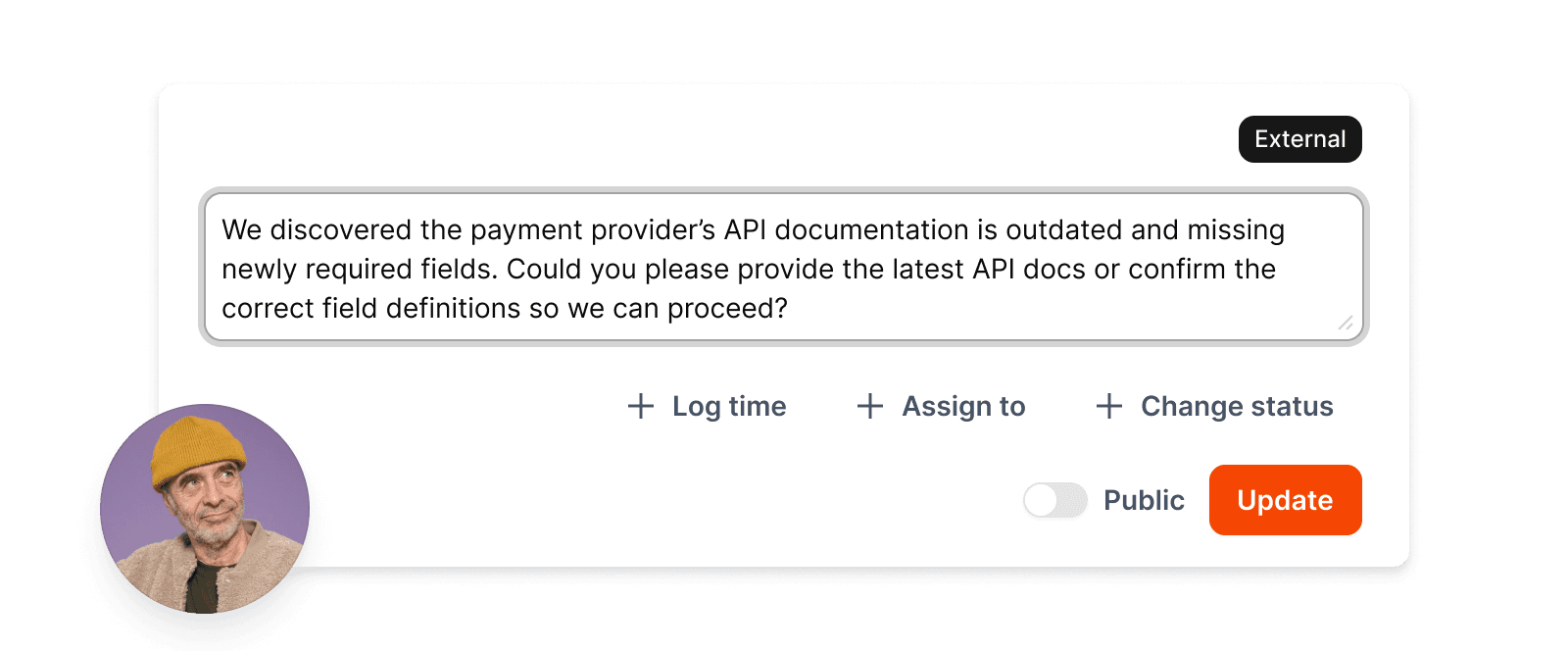
Written by
Lukas
•
Jun 4, 2025
•
Analytics
The numbers don't lie. In software, it's grim:
64% of all software projects miss their deadlines and struggle with delays
47% of tech development projects in companies experience delays or budget overruns
Here's the problem: Most projects don't fail overnight. They slowly drift off course. A ticket takes a bit longer here, a handoff stalls there, and before you know it, you're in crisis mode and everyone's wondering how it happened.
The good news: With the right data, you can spot overruns weeks in advance – while there's still time to act.
The Two Questions That Decide Every Status Meeting
When you sit down with your client's project owner for your weekly check-in (and yes, you should have one), it all comes down to two questions:
At our current pace, will we hit the deadline?
Which work packages are already falling behind?
Answering these questions clearly – with data, not gut feeling – is key to building client trust and keeping projects on track.
Forecasting with Real Numbers: Project Analytics
The Leadtime Solution
Leadtime's Project Analytics shows you week by week how many hours have been logged since the project started. Combined with remaining hours in the backlog, you can calculate a projected time to completion.
Let's walk through a simple example:
A project has a total budget of 400 hours.
After three weeks at 40 hours/week, the team has logged 120 hours.
But there are still 300 hours of tickets in the backlog.
At the current pace, that means: The project is already 20 hours behind plan. Spread across the remaining timeline, that's 7 hours of delay per week – or 70 hours total over a 10-week project. That's nearly two full work weeks.

This isn't hindsight – it's forecasting. The project manager can now make a decision while there's still room to maneuver:
Increase capacity: Bring in another developer to catch up.
Adjust the timeline: If the client has flexibility, push the deadline.
Use buffer: If buffer was built in, deploy it strategically.
Whatever the decision, it gets made early, with data, not in panic mode a week before launch.
Making Bottlenecks Visible: Big Picture
The Leadtime Solution
Next step: Finding out where the delay is coming from. In Leadtime, that's what the Big Picture view and the project's Kanban Board are for.
Each work package (ticket) has a visual bar showing the time budget:
Green means: on track
Red means: budget exceeded
When a card goes red, that's your signal to ask questions. A quick conversation with the assigned developer often reveals the real story: Maybe the scope expanded, maybe unexpected complexity showed up, or maybe the developer is waiting on missing input and can't move forward.
Concrete example:
A software shop in Karlsruhe – about 25 developers, specialized in e-commerce platforms – was working on a shop relaunch for a mid-market client in 2023. After four weeks, they noticed: The "Payment Gateway Integration" ticket was deep red. Budget: 20 hours. Logged: 34 hours. And it still wasn't done.

A quick conversation with the developer revealed the truth: The payment provider's API documentation was outdated. New fields had been added that weren't documented anywhere. The developer was stuck.
The PM acted immediately: Set the ticket to "Feedback," assigned it to the client's tech lead. Within two days, the missing info was there and the project moved forward. Without Big Picture, this could have gone undetected for weeks.

The Invisible Killer: Missing Information
Not all delays come from underestimated tasks. Sometimes the blocker isn't code – it's information.
Picture this:
A developer needs to build an integration with an external system. There's a spec document, but it's outdated. New fields have appeared in the API that aren't documented anywhere. The developer can't continue, so they set the ticket to "Feedback" and assign it to the project manager.
The PM then reaches out to the tech contact at the client to get the missing info. Once it's there, the developer can continue – and the project timeline stabilizes.
The Leadtime Solution
By tracking these feedback loops directly in Leadtime, you don't waste days wondering why a task isn't moving. You see the stall immediately and can act.
The Weekly Rhythm: The Secret Ingredient
All of this works best when it's part of a fixed rhythm. We recommend setting up a brief weekly standing meeting with your client's project owner. In this meeting:
The project manager reviews current progress using Project Analytics
Flags potential delays before they become critical
Discusses red tickets in Big Picture to understand blockers
Agrees on actions to keep the project on course
This regular cadence builds trust with the client – they see transparency, not surprises. And internally, it gives the team the clarity they need to adjust in time.
Why This Matters
Most project overruns don't happen because teams are lazy or clients are unreasonable. They happen because nobody noticed the drift early enough. Without clear forecasting, delays hide in plain sight until they're too big to easily fix.

Leadtime changes that. By combining time data, backlog analysis, and visual task tracking, it turns weekly check-ins into early warning systems. Instead of reacting to overruns, you anticipate them – and act with confidence.



